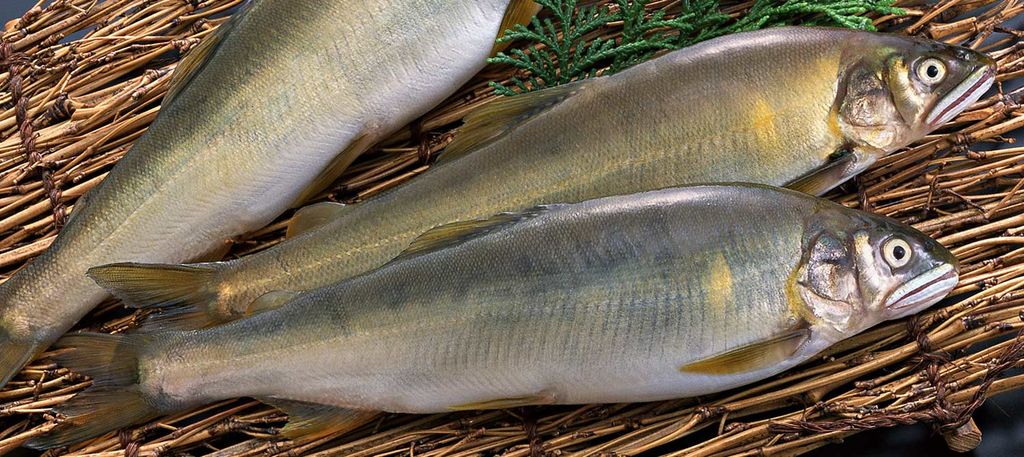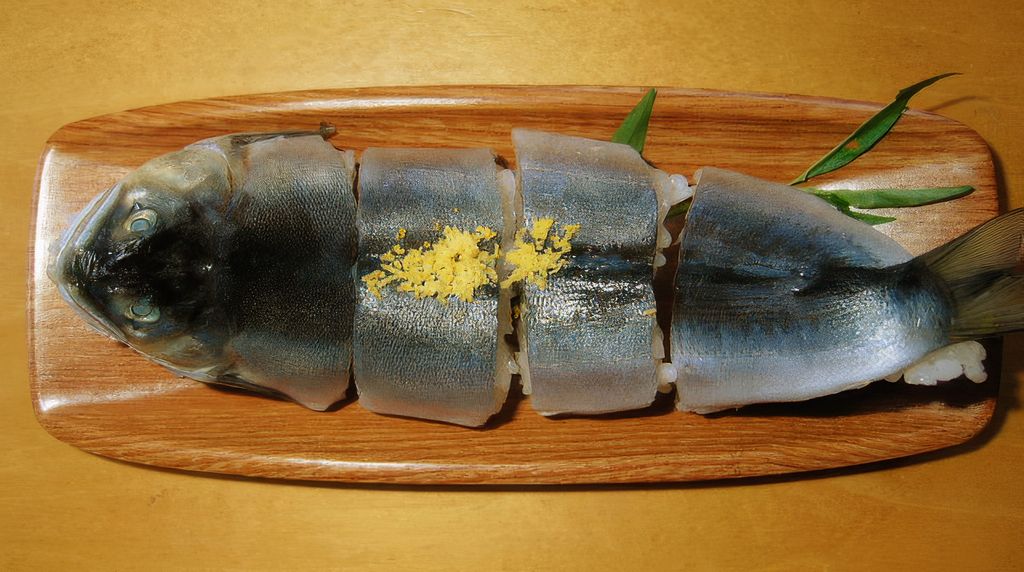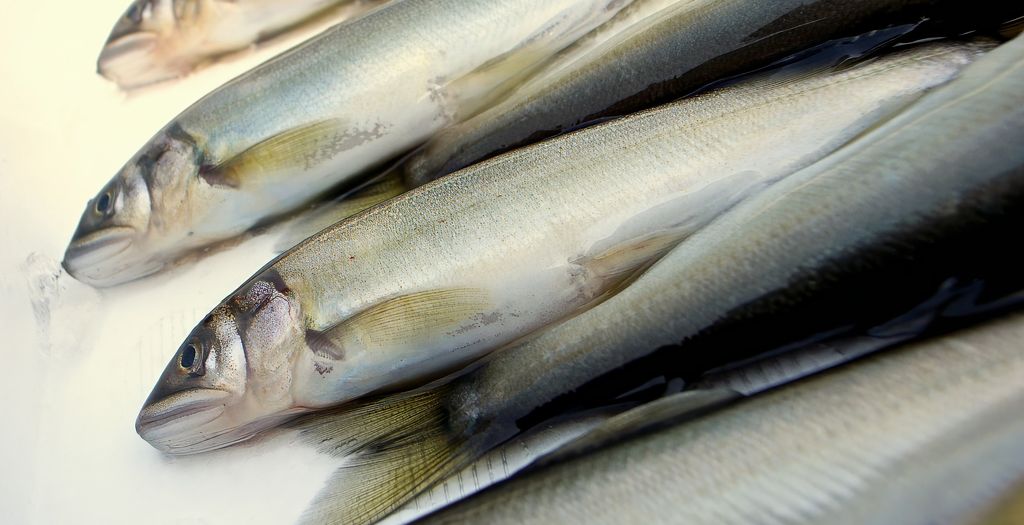Ayu Sushi
A Comprehensive Overview of Ayu Sweetfish in Japanese Sushi Cuisine
アユすし 、 鮎寿司 
What is Ayu?
Ayu, commonly called “sweet fish”, is a stint-like fish that spawns in autumn and tastes best when it has gained fat over the summer months. Young ayu (waka-ayu 若鮎), on the other hand, are caught in spring. Ayu is not only a popular fish in Japan, but is also firmly connected to Japanese tradition and culture. It is characterized by its tender flesh and unique, slightly sweet taste, which has earned it the nickname “river fish with the scent of watermelon”. In traditional Japanese cuisine, ayu is prepared in a variety of ways, from grilling to steaming to use in sushi, which underlines its versatility and popularity.
Ayu as Ingredient for Sushi or Sashimi
Since ayu is a freshwater fish, it is not a traditional Edomae sushi ingredient. Due to historical circumstances and the custom of not eating ayu raw, today it is usually served as a cooked, steamed or braised ingredient.
When the ayu fish appear, this is the sweet sign of summer.
Japanese phrase
For the preparation of sushi or sashimi, where ayu is utilized as a raw ingredient, it is imperative to source the fish from reputable aquaculture facilities. This recommendation stems from the critical need to mitigate the risk of parasite infestation, a concern commonly associated with wild-caught specimens. Aquaculture-raised ayu are generally considered safer for raw consumption due to controlled breeding and feeding practices that significantly reduce the likelihood of parasite presence. Ayu represents an intermediate host for parasites, especially for the Yokogawa sucker worm (Metagonimus yokogawai). In addition, the Japanese Food Safety Commission strongly advises against the consumption of wild-caught raw ayu due to the aforementioned problems [1].

Non-disclosed author. Fresh Fish on Surface. All rights reserved ©
Don't be fooled by its inconspicuous appearance, ayu appeals by its excellent taste. Ayu is a highly valued seafood in East Asia because of its unmistakable sweetish taste, whose aromas are said to remind of melon and cucumber. It has a pleasant texture and a strong umami taste. The intense taste known from wild-caught ayu fish is not present in fish from controlled breeding.
Compared to wild-catches, farmed fish from aquacultures have a very high fat content. When prepared raw, they are about three times as fat. When they are prepared in whole, the internal organs have more than five times the fat content of wild-caught fish. It is not unusual to cook ayu with its innards. The bitterness of the offal is considered an important part of the taste. Ayu from aquaculture is available all year round. You can distinguish a wild-caught ayu from an aquaculture bred one by its appearance: Wild-caught specimens have a long, pointed chin, which they need to scrape the algae from the ground or the rocks. Farmed ayu, on the other hand, have a darker color. Another significant difference is the price: Wild-caught specimens are significantly more expensive and less available than aquaculture products.
As opposed to the usual Japanese way of preparing fish, the best quality ayu specimens are not used for making sushi or sashimi, but ayu is most often grilled fresh with salt over charcoal. The fish is put on a skewer in such a way that their body forms a wave, making them look as if they are swimming (uneri gushi うねり串). Furthermore, ayu can also be cooked extremely well or prepared as tempura.
Traditional Ayu Sushi

エコ殿様. Ayu Sugata-Sushi. wikimedia.org. Some rights reserved: CC BY-SA 4.0 DEED. Changes applied: brightness, contrast, noise, white balance
Traditional ayu sushi 鮎寿司, an historic dish of Japanese cuisine, is characterized by its unique preparation and characteristic taste. Wild ayu is prized for its aromatic, slightly sweet taste, which comes from the fish's natural diet in the wild. To make traditional ayu sushi, the fish is typically first salted and then marinated in rice vinegar to ferment the fish. This process, which can take several weeks, gives the traditional sushi its unmistakable sour taste and preserves the fish at the same time. The result is a delicacy that is prized for both its taste and its shelf life.
Ayu in Japan
Ayu are — because of their intensive smelling slime coating — also called “scented fish” 香魚. The scent is said to be due to the fish's diet that consists of crustaceans, insects, sponges, worms, blue, pebble and gold algae that grow on the rocks of flowing streams. This unique scent only applies to wild-caught ayu. With ayu from aquacultures, this smell is perceived only very weakly. Japanese people say: the fish tastes best where the algae are numerous and healthy. Furthermore, ayu living in rivers and streams typically maintain a feeding ground that they stubbornly defend. Accordingly, there is a saying in Japanese that someone is as “persistent as an ayu”.
Lake Biwa in Shiga Prefecture and the Nakagawa River, which flows through Tochigi and Ibaragi Prefectures, are known for the quality of their ayu fish. Traditionally, ayu is mainly caught in pots and baskets. As a tourist attraction, tame cormorants are still used to catch ayu in some places. The Japanese cormorant, called umiu ウミウ in Japanese, are tamed birds for this purpose. The bird catches the ayu, stores it in its crop, and then brings it to its owner. The most important methods for obtaining ayu are fly-fishing, using a fish trap and fishing with live bait (ayu no tomo-dzuri アユの友釣り). The bait is a live ayu on a hook that swims when plunged into the water. The live bait provokes the territorial behavior of other ayu, which attack the “intruder” and get caught on the hook of the angler.
The traditional names used to describe the fish are “fragrant fish” (because of its unique scent), “annual fish” (because it usually lives only one year), “silver-lipped fish” (because its mouth glows silver when it swims), kisardashi (means sardine in a mountain stream) and “scaled fish” (because of its small scales).
In Japanese poems, the kanji characters for ayu 鮎 and 鵜飼 are associated as a synonym for summer. The seasonal variations of ayu are distinguished by specific names that reflect their developmental stages and the time of year they are typically found. In spring, the juvenile fish are referred to as waka ayu 若鮎, denoting their young age. The term waka translates to “young,” indicating that these are the newly hatched or immature ayu emerging in the springtime. As the season transitions to autumn, the term ochi ayu 落ち鮎 is used, with ochi meaning “falling.” This nomenclature suggests a time when ayu begin to migrate downstream, following their life cycle's natural progression as they mature and prepare for the spawning season. During winter, the ayu fishes are known as hio ayu 氷魚, where hio signifies “ice”. This nickname reflects the colder season during which these fish are caught, emphasizing their ability to inhabit in cooler water temperatures.
Characteristics and Ecology of Ayu

yoppy. 鮎. flickr.com. Some rights reserved: CC BY 2.0 DEED. Changes applied: brightness, contrast, noise, white balance
Although the fish is also called “annual fish” 年魚 due to its typical life span of about one year, some individuals live two to three years. The color of the young fish is grey-green/silver-grey with a golden shimmer. It changes its body color during sexual maturity in autumn to orange and black (called sabi ayu).
Wild ayu spawns in autumn in the lower part of the rivers and lay their eggs in small pits, which they hide in the gravel. Some die after reproduction and then lived only one year. Others migrate into the ocean. They usually spawn up to three times, moving to the lower part of the rivers each time in autumn. In Japan, some populations live their whole life in fresh water and move only between lakes and the corresponding rivers where they breed. Most populations of this species are amphidromic. The populations whose access to fresh water is restricted typically reach an age of two or three years. Although there are reports of ayu up to 70 cm long, a maximum size typical for the species is about 30 cm. Ayu that spend their life in fresh water are much smaller than the amphidromic form. The ayu of Lake Biwa (freshwater), which migrate to their spawning streams in spring, can grow up to about 15 cm long. Those fishes that migrate later in the year (autumn) only become 10 cm long. This is due to the different availability of food. Usually, waka ayu (young ayu) are only about the 6 cm long and very dainty.
Its distribution extends from the northwestern Pacific Ocean in Japan along the coast of Hokkaidō southwards to the Korean Peninsula, China, Hong Kong and North Vietnam. A few inland populations also exist in Japanese lakes, e.g., Lake Biwa 琵琶湖. It is an important fish for Japanese river fishing and for many local governments ayu even functions as a symbol of the city.
In aquaculture, adult fish are mainly farmed for human consumption. In various parts of Japan, however, seedlings are also raised for resource conservation and sport fishing. The main production areas are Shiga Prefecture, Tokushima Prefecture, Aichi Prefecture, Wakayama Prefecture, Gifu Prefecture, Aichi Prefecture and Shizuoka Prefecture. Near Tokushima, Aichi Prefecture and Wakayama Prefecture are the largest fish farms located.
Season Calendar for Ayu
The calendar shown does not provide information on fishing times, but marks the periods in which ayu is considered particularly tasty.
Video about Ayu Sushi
External video embedded from: youTube.com. Credit 【NIGIRU TV】鮨職人SUSHI太郎. 寿司職人によるアユの握り寿司と姿寿司と塩焼きの作り方!〜How to making sweetfish sushi〜.
Species of Ayu
The following species are regarded as authentic ayu. Either historically, according to the area of distribution or according to the common practice in today's gastronomy:
Sources and Further Reading
- [1]『寄生虫による食中毒にご注意ください (Beware of food poisoning caused by parasites)』. 食品安全委員会、 2014-09-26. Source retrieved 12/29/2021
- Rainer Froese, Pauly Daniel. FishBase. The Leibniz Institute of Marine Sciences at the University of Kiel, FishBase.org, 2019. Source retrieved 12/24/2020
- 昌髙藤原. 『ぼうずコンニャクの市場魚貝類図鑑 (Bozu Konyaku's Market Fish and Shellfish Book)』. Bozu Konnyaku Co., Ltd., Tokyo ぼうずコンニャク株式会社東京, zukan-bouz.com、 2020. Source retrieved 12/27/2021
- IUCN Red List of Threatened Species. Version 2023-1
Image Credits
- Non-disclosed author. Fresh Fish on Surface. All rights reserved ©
- SushiPedia. Ayu Sushi. All rights reserved ©
- yoppy. 鮎. flickr.com. Some rights reserved: CC BY 2.0 DEED. Changes applied: brightness, contrast, noise, white balance
- エコ殿様. Ayu Sugata-Sushi. wikimedia.org. Some rights reserved: CC BY-SA 4.0 DEED. Changes applied: brightness, contrast, noise, white balance